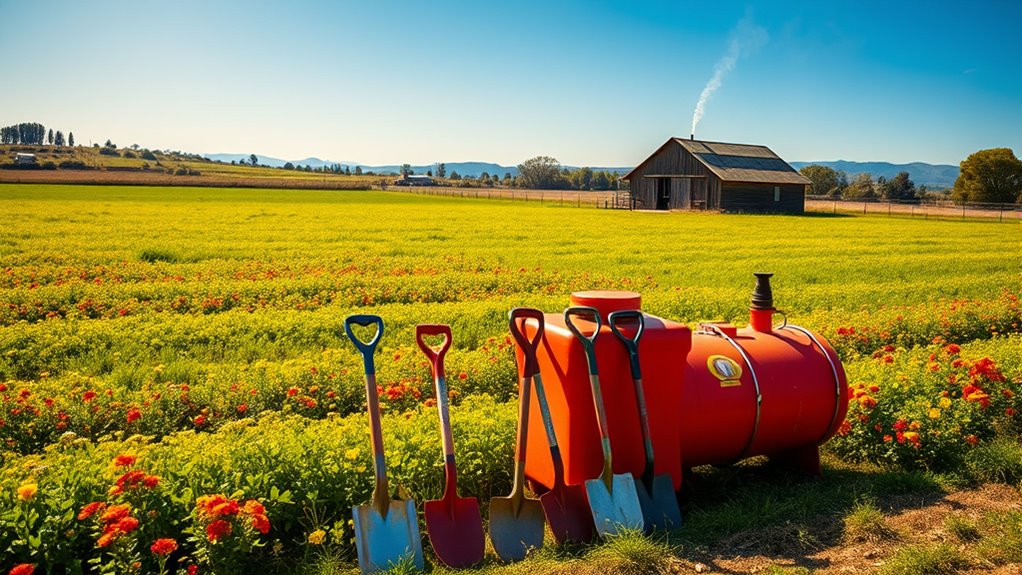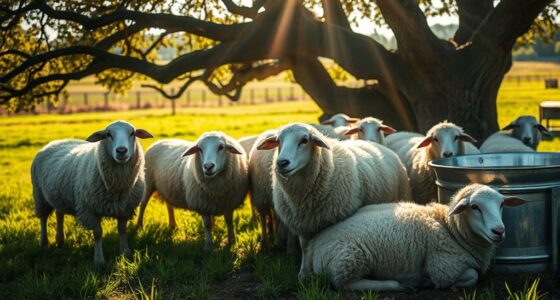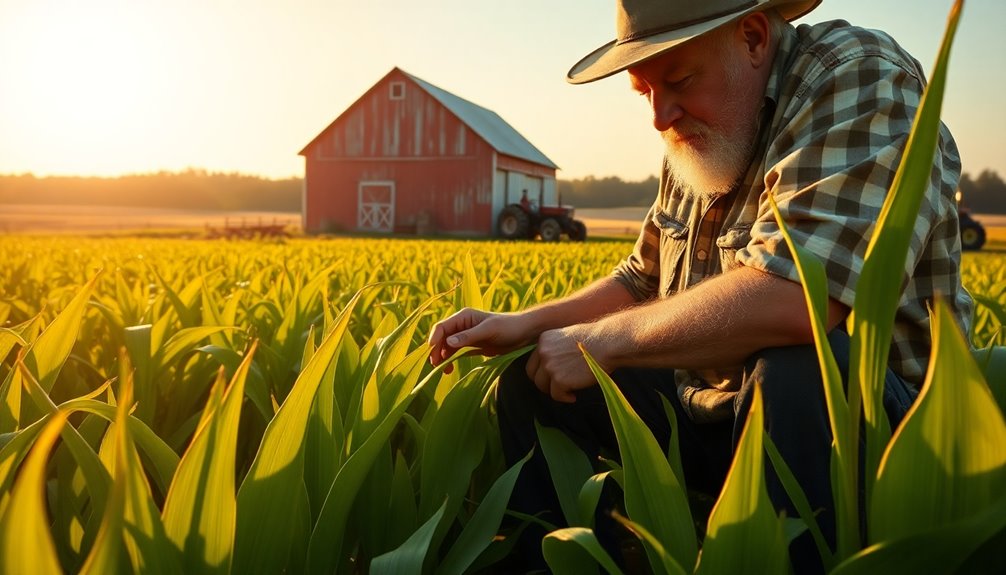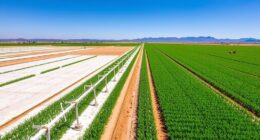To prepare your rural farm for wildfires, establish a 30-foot defensible space around structures by clearing burnable materials. Assemble evacuation kits for your livestock and document their health records in the cloud. Plan multiple evacuation routes to minimize stress during an emergency. Connect with your local fire department for resources and strategies tailored to your area. There's a lot more you can do to enhance your wildfire readiness and protect your property and animals effectively.
Key Takeaways
- Establish a 30-foot defensible space around structures by clearing burnable materials to reduce wildfire fuel.
- Assemble evacuation kits for all animals, including food, medications, and health records stored in the cloud.
- Identify multiple evacuation routes that accommodate large trailers for quick and safe animal transport.
- Regularly communicate with local fire departments about access points and available water sources for firefighting.
- Educate the community on fire preparedness and engage in local efforts to strengthen wildfire prevention strategies.
Preparing Your Farm or Ranch

When it comes to wildfire preparedness, establishing a safe environment for your farm or ranch is essential. Start by creating a 30-foot defensible space around all structures, clearing away burnable materials that could fuel a wildfire.
Make certain hay is completely dried before storage to avoid fire hazards like spontaneous combustion.
Ensure hay is thoroughly dried before storage to prevent fire risks, including the danger of spontaneous combustion.
Identify and establish multiple evacuation routes that can accommodate firefighting vehicles, as traditional paths might be blocked during a wildfire.
Regularly inform your local fire department about access points and water sources on your property to enhance firefighting efforts.
Finally, prepare an emergency plan for livestock evacuation, including an evacuation kit with food, water, and identification documents to guarantee their safety during an emergency and contribute to community safety.
Preparing Your Horses or Livestock
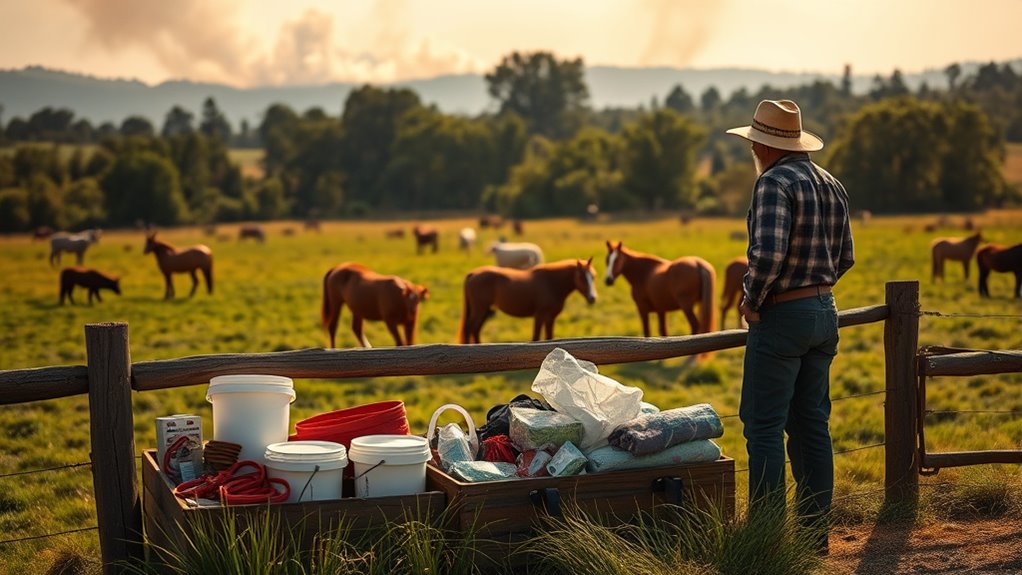
As wildfires pose a significant threat to rural farms, preparing your horses or livestock is crucial for their safety and your peace of mind.
Start by assembling an evacuation kit for each animal that includes essential supplies like food, water, and first aid items.
Create a clear evacuation plan and practice it, making sure everyone knows their roles.
Document your livestock's health records and identification details, storing this information in the cloud for easy access during an emergency.
Identify multiple evacuation routes to guarantee a safe exit from your property.
Additionally, consider hiring an animal emergency response team to assist with planning and secure your livestock's safety during fire threats.
Your proactive steps can make all the difference.
Evacuation Strategies
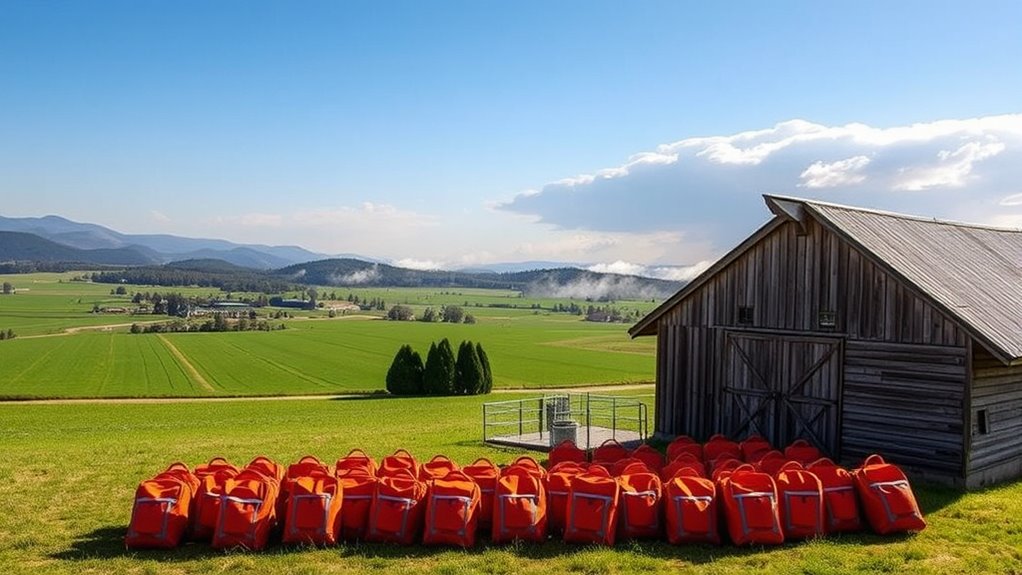
Planning effective evacuation strategies is essential for protecting your livestock during a wildfire. Evacuate your animals early during voluntary evacuation to reduce stress and guarantee safety.
Identify multiple evacuation routes ahead of time; wildfires can block usual paths, so these should accommodate large trailers. Prepare an evacuation kit for each animal, including food, water, identification documents, and medications.
If evacuation isn't an option, shelter your livestock in defensible areas cleared of flammable vegetation and debris. As a last resort, consider letting them loose to escape the fire, but make sure they can't return to unsafe barns or pastures.
Your preparedness can make all the difference in keeping your livestock safe during an emergency.
Additional Resources

Having a solid evacuation plan is just one part of a thorough wildfire preparedness strategy.
To enhance your wildfire prevention efforts, explore resources from the Texas A&M Forest Service, which offers educational materials specifically for landowners. Utilize the "Map My Property" tool to create detailed maps identifying water sources and sensitive areas on your farm.
Additionally, the National Fire Protection Association and Firewise USA provide guidelines to help communities develop effective wildfire mitigation strategies.
Don't overlook FEMA's extensive wildfire preparation guide, emphasizing planning and preparedness.
Finally, connect with your local fire departments; they often have valuable resources and programs to educate you and your community on wildfire prevention and preparedness practices.
Insights and Expertise
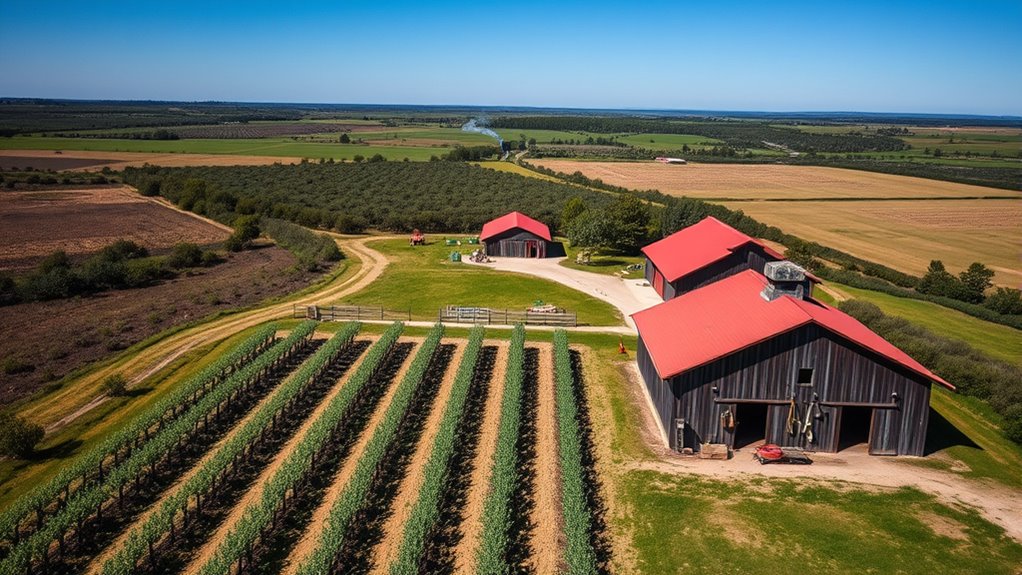
While understanding wildfire risks can feel overwhelming, tapping into expert insights can greatly enhance your preparedness efforts.
Landowners play a crucial role in wildfire prevention, especially since over 90% of wildfires in Texas are human-caused. The Texas A&M Forest Service offers valuable resources, like the Map My Property tool, to help you assess and manage your land effectively.
Engaging in community education can also bolster fire preparedness. Rural fire departments, often operating on limited budgets, rely heavily on volunteers to provide essential education on creating defensible spaces and practicing safe burning.
Frequently Asked Questions
How to Fire Proof Your Farm?
To fireproof your farm, start by creating a defensible space around all structures by clearing away flammable materials.
Use fire-resistant materials for your buildings and keep roofs clear of debris.
Store hay in multiple locations to reduce total loss risk.
Prepare an evacuation plan for livestock, with kits ready.
Regularly assess your fire safety measures, ensuring you have accessible water sources and clear roads for emergency responders.
Stay proactive to protect your property.
What Are 90% of Wildfires Started By?
Over 90% of wildfires are started by human activities. You mightn't realize it, but careless debris burning, sparks from equipment, and discarded smoking materials are common culprits.
When you're burning debris, make sure you have control measures in place. Always check local burn bans, too; conditions can change quickly. Ignoring these factors can lead to unintended fires, especially in dry conditions.
Stay informed and practice safe habits to help prevent wildfires.
What Are Wildfire Preparedness Tips?
Imagine your home as a fortress, standing strong against the flames. To prepare, you'll want to create a 30-foot defensible space, clearing away burnable materials.
Keep your local fire department informed about access points and water sources, ensuring they can respond quickly. Assemble evacuation kits for your pets, and practice your plan regularly.
Stay updated on wildfire activity, and safeguard important documents in waterproof containers to protect what matters most.
How Can We Prevent Fire in Rural Areas?
To prevent fire in rural areas, you should start by being aware of local burn bans and practicing safe burning methods.
Create a defensible space around your property by clearing away flammable vegetation and debris. Keep your roof and gutters free of leaves, as they can ignite easily.
Using fire-resistant materials for your buildings enhances safety, and staying updated on weather patterns helps you take timely action against potential fire risks.
Conclusion
As you gear up for wildfire season, think of your farm as a ship steering through stormy seas. With proper preparation, you can steer clear of disaster. Equip your vessel—your land, livestock, and evacuation plans—like a captain readying for a tempest. Just as a skilled sailor relies on their compass and crew, you'll find strength in knowledge and community. Stay vigilant, stay prepared, and you'll weather any wildfire while keeping your farm safe and thriving.

